Photo
How tf did this get so many notes?
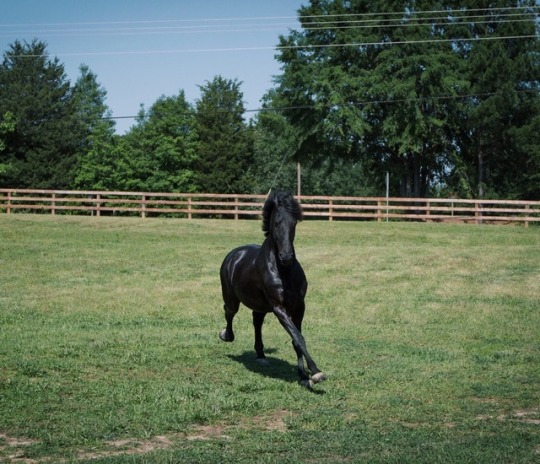

someone’s enjoying turn out after stall rest!
577 notes
·
View notes
Text
I saw the greatest thing today. So I’m at a stoplight in the passenger seat, right? And I hear hoofbeats nearby. I look over and there’s a lady walking her horse. We’re close enough to be in talking distance and this horse is incredibly happy. Her ears are pricked forward and she’s JUST SO DELIGHTED TO SEE EVERYTHING.
“I like your big dog!” I said.
“Thanks! She’s an asshole!” she said, and the horse headbutted her so hard she staggered. SHE JUST LOVES THIS HORSE SO MUCH, GUYS, she laughed and patted her nose.
62K notes
·
View notes
Text
“what happens when men pretend to be trans and use it to peek on our daughters?” you mean that you’re taking away the rights of trans people…. who have no history of such behavior…. bc you’re nervous about how cis men will abuse a right that isn’t even theirs …. idk susan maybe spend more time and energy talking to the cis men you’re scared of and explaining why it’s not right to be a predator instead of making passionate facebook posts about how validated you feel in taking away someone’s basic safety…..
12K notes
·
View notes
Text
i have been thinking a lot about superheroes, and how the millennium children were born without one. we live in the aging heroes of our parents and grandparents, the familiar stories with problems from eras before our own; where victory comes as a result of hard work and dedication, where goodness and truth are a promised ending.
our heroes got old. our heroes had life breathed into them again only for us to start seeing the problems: it was fantasy, there was nothing to believe in. our heroes haven’t been reborn, only a few new ones have been made. we grew up reading about worlds where justice meant something only to wake up where justice is unequal, where rich means powerful and rich means getting away with it and rich means the hero comes to dinner with you instead of spending it in brooklyn on the subway.
we watched other people get married in princess costumes in parades we’d not be able to afford. our heroes wouldn’t cater to us, we didn’t have the money to invite sleeping beauty to our baby shower. we bought movies where captain america punches nazis only to be told that we shouldn’t fight nazis. batman strings up criminals but a boy found guilty of violent assault gets off with a walk. robin hood refuses to show up, we’re forced to crowdfund cancer survivors as the wealthy get tax cuts. we love superheros, watch all of the x-men movies even though the timeline makes no sense anymore - but they’re not born from our struggles. they’re not coming from our wars.
why are there so few heroes anymore.
1K notes
·
View notes
Photo
I was waiting for this to be gif and preparing to be horrified.
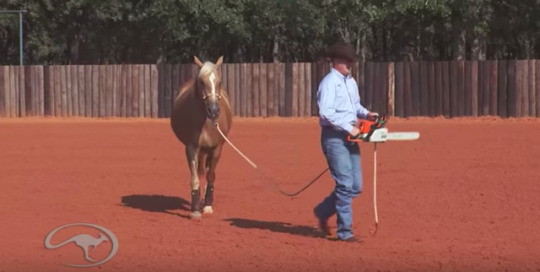
clinton no
171 notes
·
View notes
Text
new personality test: the sound u make trying to get a cat to come to you
46K notes
·
View notes
Photo

she's pretty cute
4 notes
·
View notes
Note
For the horseblr ask meme, 10 and 14. :)
10. I feel like I've learned so much about barefoot trimming and horse psychology here!! It's crazy the amount of informational posts people make, it totally blows my mind and has taught me so much. 14. I've definitely incorporated more +R training into my riding since joining Tumblr. I never even considered it a few years ago, but now it has its place in my day-to-day interaction with Diamond. She says thank you :))
2 notes
·
View notes
Quote
Persephone, grant me the foresight to know when I must let go my old life to start anew.
Artemis, grant me the strength of your spine when you helped deliver Apollo, your own twin.
Athena, grant me the solidarity in your sinews for which you were born in all of your armour.
Aphrodite, grant me the kind of heart that always follows my passions true.
Andromeda grant me the wish to never fall out of love with the night sky or the glisten of it’s stars.
And Hera, grant me your fury, so I can remind my enemies I am not the weakness they perceive, I am the oncoming storm, I am war.
Nikita Gill, A Woman’s Prayer To The Goddesses (via meanwhilepoetry)
3K notes
·
View notes
Text
shouldn’t saddles fit well enough that you don’t have to use a half pad? my trainer adamantly forces everyone to use half pads. even people with custom saddles use half pads. wouldn’t it be better just to get a saddle that fits? i think half padding all these saddles is ridiculous. just get a saddle with good flocking that fits well.
78 notes
·
View notes
Conversation
horseblr ask meme!
i got bored so i made a thing for us all, rebagel away!
1. What made you join horseblr?
2. What tags do you track?
3. The first blog you remember following?
4. The first blog you remember following you?
5. What is your most popular post?
6. Tag your favourite #aesthetic blog?
7. Who are your five favourite blogs?
8. Who are your five favourite bloggers?
9. Five horseblr horses you'd like to ride?
10. Favourite thing/s you've learned since being here?
11. Favourite dramatic event in horseblr history?
12. Who are five users who are either rarely active anymore/inactive/deactivated who you miss?
13. Favourite horse related thing to see on your dash and/or the content you enjoy most?
14. Have you ever done anything differently or tried something new because of something you've read here?
15. Something you would like more of on here?
93 notes
·
View notes
Photo

is it time for frank cho and milo manara to die or what
366K notes
·
View notes
Text
Lexi’s month-in-the-making Lunging with Sidereins masterpost!
Why Lunge?
Now this whole post runs of the premise of, if you’re going to lunge, use sidereins. But why lunge in the first place?
Those of you who have followed me for a while are probably sick and tired of hearing me use this example, but here I go again: if I can’t squat with my own body weight, what hope do I have of doing it with a weight? And the exact same principle applies to horses.
If your horse is physically capable of holding itself in an outline and staying balanced in transitions between and within the pace, from a circle to a straight line up the track, from a smaller to bigger circle, then you are going to have a much easier time under saddle. Why have a fight that you don’t have to? Why have a fight which is unfair for one party who hasn’t been given every possible chance to succeed? Furthermore, lunging allows you to mentally prepare your horse - they know what you are after because they’ve already done it. You have your voice aids established, and then it provides you with a chance to establish contact, so that when you hop on, they aren’t confused. That is where side reins come in to the equation. So basically, it significantly cuts down that long process of corrections and little arguments about coming into the contact, simply because they are confused (and let’s be honest, be gently on this but don’t pull on it, but don’t be behind it - that isn’t exactly straightforward for the horse!). If you lunge them into a contact, and their habit is going correctly into that contact, that will translate far better under saddle. Be a fair partner and set your horse up for success. That is why I love lunging.
Before I start, I’m going to put it right here - I do not attach my lunge line to a bit. For me, the bit is about contact. No matter what way you attach a single lunge line to the bit (because double lunging or long-reining are different) you aren’t mimicing contact. If you attach it to the outside ring and over the poll or under the nose, the bit is going to pulled laterally. If you attach it to the inside ring only, the bit will be pulled laterally. There is always more pressure in one direction because there is only one rein. The bit is reserved for contact, and lunging off of the bit doesnt mimic contact - which is my same argument against many of these othertools, as you’ll see. So anyway, I use a lunging cavesson (because a halter is also far from ideal), with the cavesson over the bridle, and side reins to the bit. Here is some info on lunging cavessons.
Rundown of Lunging Aids
Chambon/de Gouge
Chambon

A chambon runs from between the legs, splits, and goes over the poll and down to the bit.
I am not a fan because they don’t mimic contact. It uses more poll pressure and exerts almost entirely downward pressure, whereas directionally, contact comes from behind the horse - a line from a rider in the saddle to the bit.
De gouge

A de Gouge is similar, but runs from between the legs, through the bit, over the poll and connects back down where the reins split.
Totally speculating here as I haven’t used one or seen one used, but from just looking at the action, it looks more severe than a chambon. The third one I have seen is basically the de Gouge but it ends at the poll, doesn’t reconnect back to the tool. So just the opposite attachment of a chambon.
My basic judgement on these tools:
They help with gymnastic stretching but not really working correctly. It doesn’t replicate contact nor does it intend to (Contact does not come from between and under the forelegs. Side reins replicate the direction of the reins - they come from behind the horse, not from under.) I’m going to say it now and will repeat it often, but ability to stretch into nothing versus having a good relationship with contact are different skills.
Unless you are trying to desensitise your horse to poll pressure and make them more amenable to a double, I do not recommend this tool. Contact is taught into a snaffle, not the poll, this is why the snaffle comes before the double, always.
If the horse finds poll pressure quite aversive, they may drop the head and either tear a muscle, or just fall totally on the forehand.
Pessoa
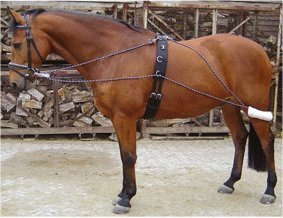
Here is video of the Pessoa in motion.
So you have one piece which starts at the top hole of the surcingle, down through the bit (technically through a clip which attaches to the bit), then back through a surcingle ring and to the hind end, with another piece coming directly from the top hole to the hind end, as you can see in the pic above.
The concept of this shits me because you have a rein attached from the hind end to the mouth, and a horse whose body extends at different points of the stride. This is a recipe for bridle lameness. I’m not against the use of the hind end portion (I’m a big fan of the Equiband system using therabands), and then attaching Sidereins to the surcingle somewhere else, but having the two portions together is a good way to ruin a mouth.
Vienna/Running reins

Running reins run from between the legs, up through the bit and back up to the surcingle.
I don’t mind these as they go in the direction of contact but again, the two direction thing means they aren’t as ideal, especially if using them as a pre-breaking thing for babies, as sidereins. I haven’t used them myself so can’t really say much more.
Side Reins
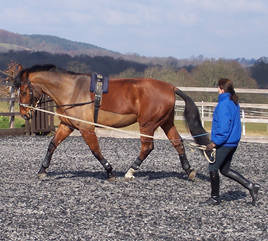
Side reins run from the girth or surcingle to the mouth in one straight line.
Double Lunging/Long Line
Double Lunging

Long Lining
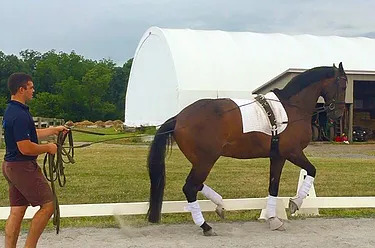
Putting these here because I consider them a follow on to lunging. There will come a time when you have achieved all you can with lunging and need to move on, if you can. But I believe lunging has too many benefits to skip straight to long lining, and I believe side reins are the best method (except maybe running reins but again haven’t used them) hence why I’m doing this post!
Types of Sidereins
Elastic
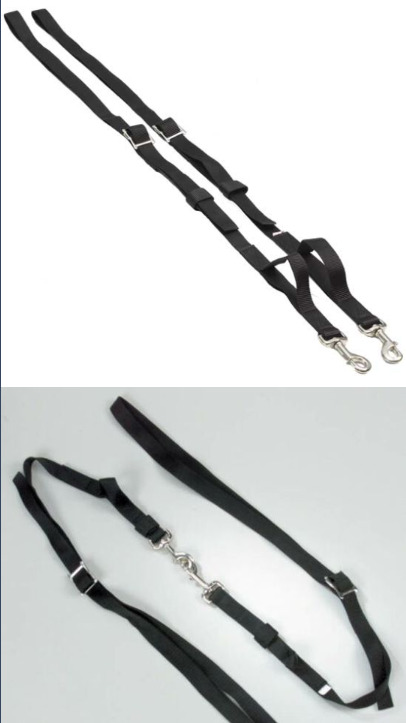
These have heaps of give - but not in the good way! They let the horse just completely lean on them, then the give is less noticeable when they do give. It doesn’t reflect the elasticity of a human hand, which gives for a reason and with good timing, this will just let them lean and lean. I like the quote from this website:
Elastic acts like a harsh hand: when the horse pulls, there is not enough resistance. The lack of firmness teaches to horse to use strength. And when the horse gives in, the elastic pulls back to “un-stretch” and builds up pulling strength. A non-elastic side rein resists without stretching, and gives in at the very second the horse gives in. Therefore, the non-elastic side reins are never harsh. They do not make mistakes. They are firm when they have to resist and they always give in at the right moment. Non elastic side reins are like a very good hand.
Donut Ring

These have less give than elastic, but still more than non-elastic. If you have a horse who is too light and sucks back, these might be more appropriate for you. But otherwise, I’d stick with non-elastic.
Solid Leather
The best, you just have to ease the horse in gently. The best way to tell is just to do the stretch test, but I mean generally if they’re leather with elastic they’ll look like the top pic in the elastic section, if they’re solid leather they will kind of just look like stirrup leathers, they will 100% be leather.
Why Lunge with Sidereins over other tools, or over no tools at all?
Your short answer - CONTACT.
While sidereins allow us to train the horse to be good on the contact and strong enough to hold themselves in an outline, it all comes back why we want contact in the first place. So I’m going to give an analogy of why, in this context, contact helps us.
Let’s just pretend the horse’s spine is one of those flexible rulers which bend. Let’s also say that you put one end of this ruler against a flat hand, and then push the other end with your other hand. It bends, either by going up (rounding the spine) or going down (hollowing the spine). In this example, the flat hand is your contact, your ‘closed door’ The pushing hand is your horse’s drive from the quarters.
Those ‘Crunches’ the Intrinzen Program do (essentially a pelvic tilt) also use this. The recommended way of teaching it is against a fence or wall. The horse pushes backwards, and hits a ‘closed door’ . They round their back in response, instinctively.


So basically, if we have side reins, we create that ‘closed door’. The energy from behind is caught, and so goes upwards. Some things to note here are that (a) if you start with the side reins too tight, the horse has no chance of raising the back, and will respond by hollowing. The stronger the contact, the more strength and push from behind is required to lift. But that also (b) the stronger the contact, the more that they will raise the back. This might sound contradictory, but what I’m trying to say is that while you can’t start tight, if you work them on loose side reins forever, you will get minimal improvement. If that gate in the photo above was made of foam and had more give there would be less of a dramatic rounding in the back. Every action has an equal and opposite reaction and all that physics stuff. I hope that I’ve made that clear, and if not then message me, but basically - challenge them. The more you tighten the sidereins, and as long as you increase that push proportionately, you will see a greater lift in the back and increase their strength.
Focussing on the back is more important than having their nose on the ground. Your horse is not going to have its nose on the ground with sidereins, or else it will be terribly curled under. That is not the point, they aren’t a “stretching tool” aka nose towards the ground tool (Not to mention that most horses who have their noses on the ground to stretch do so by loading the forehand). Side reins round and so build and stretch the back, as I’ve said above. If you have a horse who is good into the contact, and strong and supple over the back, then when you get under saddle and let those reins out the nose will follow. Read Steph’s post on stretching for more of an explanation on how good contact leads to good stretching. And then when they do stretch, you have your supporting aids there to make sure it’s a quality stretch without just falling on the forehand!
A little side note, since it may be a concern for some of you: it is not horribly detrimental if your horse is a tad behind the vertical. It’s not going to teach some awful habit to break under saddle, where they are incapable of taking the nose foeqard and out to stretch. As long as the horse is clearly pushing into the contact, you’re okay. If they come behind or off the bit, suck buck, curl - you have problems. If they are into that contact, then when you are under saddle and you let the reins out they will go ‘please, yes, let me stretch, let me take it’.
So back to it, rather than have their nose on the ground, your horse will be in more of a ‘training outline’. This is the best way to start both babies, and horses of any age starting in the lower levels and hoping to progress further. You want to build muscle in this outline because this is how you ensure that they engage over every vertebrae, poll to tail.
So by training outline, i mean this:

So that eventually, we can have this:

Higher carriage takes strength and engagement along the whole topline. If you expect that higher carriage too soon, you get this:

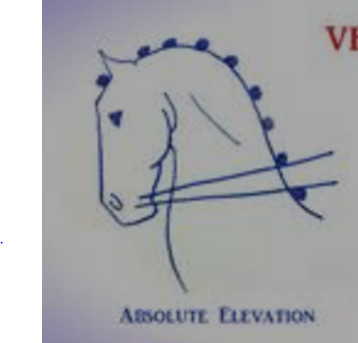
This kind of outline is awful to watch and even more so to ride. They do not feel lifted over the back, they feel stuck and terrible. So I’m after an outline where I’m going to contribute to that muscle building, more so than a nose to the ground kind of outline.
Why not just use other tools/no tools at all?
Now that I have spent forever talking about contact, the answer is that other tools, such as chambons and de gouges, don’t mimic contact. Contact doesn’t come from between and under the legs. If the horse pulls against it, contact doesn’t exert downwards pressure. While sidereins don’t replicate contact perfectly (as I have said, vienna/running reins would probably be another great tool if I had more experience with them), they replicate it far better than a chambon or de gouge. By mimicing contact they allow you to cultivate that desire to stretch and take the contact forward without the extra challenge of the rider’s weight. And again, I’ll just add that that is why you don’t want to use elastic side reins - because they take that contact too far and just let the horse literally lean on them rather than just have that gentle, consistent connection on.
The answer to ‘why not just use no tools at all?’ is that providing contact and a ‘closed door’ for that energy to push into will see a better response over the back. Those horses who can have their nose on the floor with no tools are too frequently not showing proportionate lift over the back and/or are loading the forehand. No matter how supple the horse is, adding contact changes the game and is a different question.
What horses should I use them for/When are they appropriate?
Personally, I consider them fine for any horse, but the type you use and how long it takes before you can demand more (aka tightening the side reins, more drive from behind to equal it) will differ. I consider lunging a crucial skill for any horse to know, and I think that working into sidereins is the best way to get results on the lunge. You know your horse better than I do. If your horse is pretty cool with stuff, I would start with the solids and loose. If your horse has a tendency to suck back or curl, I’d go for the donuts. If your horse is VERY thingy about contact and may panic feeling something like a siderein, then I’d rather be safe and maybe develop a horse that leans which you can fix later - I’d go for the elastic. Your safety comes first.
Do I put the inside rein shorter than the outside one?
This isn’t really the right question. The question is, is the outside rein longer than the inside? Which is yes.
If your horse bends according to the circle shape, the outside of their body will physically be longer than the inside. This means that you have to allow the bend on the outside rein. It also means that if your outside was of the perfect length for your circle line but then your inside was the same, the inside would be flopping around like a rag doll. It has to be shorter than the outside so that when you ask for flexion on the lunge line, there is still a gentle straight line on the inside rein. By that I mean, you want the strongest things to be the lunge line and the outside rein. The inside rein will not look as taut as the outside, it should look like it’s there, like it’s present, but not like it’s pulling. I have quite a difference in my outside and inside length now, but when I first started it was just one, and I had to lengthen the outside and tighten the inside one at a time, until I found that I needed to make the difference between them bigger - which is now 4 holes difference (tho to be fair, my side rein’s holes are fairly close together so it’s probably more like 3 on a normal pair).
A little side note: I use my lunge line to create flexion, rather than having the side reins pull the nose in. The lunge line has has has to be taut. If the horse falls in through the shoulder, and drops the lunge line, that is when you have the problems that most ~anti gadget~ people have with sidereins. For example, Arthur falls in to the right, as if I have no contact on the lunge line I can’t get him to flex properly - he will choose to, despite the shorter inside side rein, flex out. Because the side rein there isn’t of a right length for an outside rein, he’ll take that shorter length by breaking at the third vertebrae. So basically, your lunge line creates the flexion, and as your pon gets stronger, the bend. The side reins guide it.
Where do I attach them?
Start at the girth. Even when I use a surcingle, it’s through the girth. (While I’ve been going on about replicating contact as much as you can, if you weren’t to have them low, your pon will quite likely struggle and develop incorrect musculature. BUT you can work towards this. So at least the side reins still replicate the direction of true contact - it comes from “behind the horse”. Again on the ‘Vienna/Running reins may be better for this’ thought train.) In a perfect world, I would say have the side reins level to where you want the mouth, BUT then they go over the widest point of the shoulder and so create a see-sawing effect every time the horse moves. So yeah, mine are at the girth, which does end up creating some ‘downwards’ pressure but it remains mostly ‘backwards’. FYI, I don’t mean backwards in the sense that the sidereins pull, I mean literally that they run backwards/forwards directionally, not go up and down only like a Chambon/de Gouge.
How do I know when it’s time to tighten them?


(This is Arthur when we first started rehab (he had lunged in side reins before so this isn’t “never done it before” length) versus now. This is as tight as he will probably go for a long time, if ever)
For a completely unexposed horse, I would attach them so they are loose at the horse’s natural head carriage. Not ridiculously loose, but not ‘slightly loose’ - a couple of holes looser than slightly loose should be good. Basically they learn to feel the weight of the side rein, then you adjust them a hole at a time once they’re clearly comfortable. I haven’t started a horse like this with sidereins FYI, this is just what I’ve been told my instructor does. I knew Arthur had worked in side reins before, so I began with them just a hole or two tighter than his natural head carriage. Here’s an important thing - even though they don’t have give like elastic, your horse will push them outwards as they channel the power from the hind into the front. So even though it might be tighter than the head carriage, the way a horse moves when it is powering completely changes the way they work into contact. Those of you who ride with a focus on contact will know that if you take up the reins, you have to increase the pushing power. It’s the same philosophy here. They must push into that rein, not dawdle along and be pulled by it.
So basically the signs that you’re ready to tighten are that your horse is comfortable pretty consistently. They’re never going to be perfectly balanced in every moment, but if they are working well over the back and into the length they have, and relaxed, then it’s time to up the pressure. (When you’re starting with the side reins long, you won’t see a dramatic raising of the back - the more pressure when the power from the hind meets the front, the more dramatic the response. The horse won’t have an obvious rounding of the back until there is enough of a solid, closed front door that they hit that pressure and raise the back and have the strength to raise that back. This takes time.)
If you are also getting the impression that they are not really challenged by the work, it might be time to up them. There was a time when I was lunging Arthur and he just wasn’t really pushing into it, but showed no signs of discomfort and stress, and I upped the sidereins and the push, and he immediately moved better into them and raised his back more. Again, this is for you and your horse to work through and you know them better than I do, but listen to them.
“I’ve already been Longlining my horse, should I start lunging in sidereins?”
I view these as two techniques which work together. I would seriously recommend you go and give lunging in side reins a try and alternate it with your longlining work, and see if you find any improvements. I think you will, but who knows, you may not. Correct lunging is still a really important skill, but yeah, unless you’re looking at buying a new horse who hasn’t experienced either before, then this isn’t really a priority for you.
The use of Sidereins in breaking/starting a horse
So why would you want a horse well-experienced in lunging in sidereins before adding a rider?
The horse knows the aids between the paces, the general idea of coming in versus going out to a bigger circle, and the stop.
The horse is physically strong enough to balance themselves in the paces and transitions, in an outline
The horse understands the concept of pushing forward into a steady contact and is again, physically capable of being balanced while doing so
You set your horse up for success if they are started like this. Working balanced in an outline can be challenging for non purpose-bred horses and even for green purpose-bred horses (though you’ll find they progress faster). By starting them in this way they have the muscle to do these basics on their own before the extra challenge of the rider’s weight and their own imbalances is added into the equation. Again repeating the if you can’t squat your own body weight then you wouldn’t squat with 50 kilos’ allegory. You also set your partnership up for mental success by doing this: because your horse is more balanced, they are more likely to offer the right behaviours which you can then reinforce, so they are less likely to get confused or frustrated. Furthermore, they understand the concept of contact better. You don’t have the big drama of slowly explaining ‘push into it yet don’t pull on it’, and they are habituated to that consistent, gentle pressure (aka contact). So in summary, your pon understands you and is more capable of doing what you want so more happy rides for both of you!
And finally, the next step is that the rider hops on, on the lunge, and the association game begins. The lunger asks for canter as the rider gives the canter aid, going in or out as the lunger asks them for the same. This article here, written about my instructor’s instructor’s method (aka where mine got it from) gives a bit more explanation on that.
TLDR
Ability to raise the back without contact versus raise the back with contact doesn’t always translate - your best bet at getting a horse who feels contact and by default, lifts the back, is to practise it on the ground before the added difficulty of 50+kg
Side reins come above other tools because they most simply replicate contact on the reins. They are one line to the bit, and they work in the same direction as the bit - back and forth, not up and down, as happens with other tools.
When the horse is as consistent on one length of contact, and not bracing or hollowing the back, you can tighten each side rein a hole. Remember that the tighter the front, the more drive must come from behind to equal that and ensure they are still pushing correctly.
Side reins are a precursor to long lining or double lunging. There will come a point where progress plateaus.
The inside rein is tighter in that the outside rein is longer. The most contact should be on the outside rein and the lunge line - a dangling lunge line leaves you with little influence over the horse and should be the first thing on your fix list (please use a cavesson and reserve your horse’s mouth for contact), the inside rein should be the lightest. To allow the horse to follow on the circle shape, the outside rein must be longer.
Side reins are a precursor to breaking a young horse because it ensures that mentally, they understand the aids and how to push into a contact. It ensures that physically, they are strong enough to raise their back into a decent strength contact, and are fit.
513 notes
·
View notes
Text
For me personally, I LOVE eventing. Cross country is my favourite thing ever, but for my horses sake I committed to taking the year off jumping, and to purely focus on dressage.
I found a very qualified instructor, I now work for him and take regular lessons. It's helped my riding so much! I can't wait to get back to jumping (only 5 more months!) But I know that a lot of issues I was having will be fixed from my focus on dressage. My posture, my relationship and understating of contact, etc. I think everyone would benefit from a good dressage foundation.
Those of you who are straight (not heterosexual, but like only) dressage riders: why did you choose just dressage? I know so many explanations for why eventing and why jumping and all that, but I don’t hear many about dressage.
137 notes
·
View notes
Video
little walk around the farm
#I've literally lost so much inspiration this week#idk why but I'm just exhausted#I've done nothing but trail ride and groom this week and my instructor is gonna kill me for it#I'm just tired I guess
1 note
·
View note
Photo
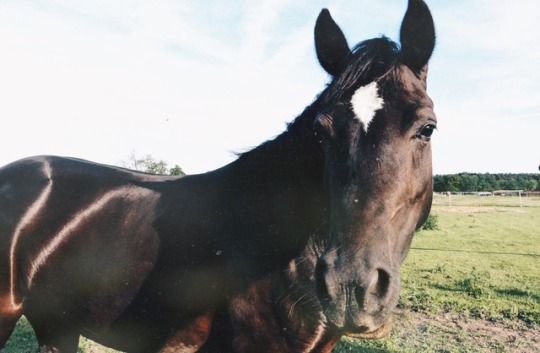
but it’s too late,
she believes in fate,
she’s absolutely smitten,
she’ll never let you go ~
325 notes
·
View notes